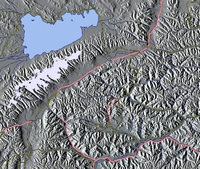
Photo from wikipedia
Abstract Reconstructing the evolution of the Bangong-Nujiang Tethyan Ocean (BNTO) plays an indispensable role in understanding the linkage between Gondwana dispersion and Tibetan Plateau accretion. The existence of the BNTO… Click to show full abstract
Abstract Reconstructing the evolution of the Bangong-Nujiang Tethyan Ocean (BNTO) plays an indispensable role in understanding the linkage between Gondwana dispersion and Tibetan Plateau accretion. The existence of the BNTO is inferred from presence of dismembered ophiolite bodies along the Bangong-Nujiang suture zone, which separates Lhasa from Qiangtang. In this paper, we present a detailed synthesis of ophiolite, metamorphism, magmatism, lithostratigraphy and tectonism from the western segment (Gerze area) of the Lhasa-Qiangtang collision zone in order to reconstruct the Wilson cycle of the BNTO. Our results suggest that the BNTO initially opened in the Late Permian (~260 Ma), as indicated by the earliest record of oceanic crust. Regionally, strong evidence supports a northward subduction of the BNTO beneath Qiangtang, likely initiating in the Early Jurassic (~195 Ma). As suggested by detrital zircon age spectra from Mesozoic arc-sourced strata, northward oceanic subduction generated three episodes of arc magmatism, i.e., ~186–170 Ma, ~169–146 Ma and ~129–100 Ma along the southern Qiangtang margin, in which the Early Jurassic magmatism is only sporadically preserved in modern outcrops (Amdo area). Meanwhile, the recognition of an incomplete arc-trench system on the northern Lhasa margin supports a southward subduction beneath Lhasa as well. Our new provenance data from Lower Cretaceous strata on the northern Lhasa margin, together with available multi-disciplinary constraints, suggest that final closure of the BNTO did not occur until the latest Jurassic-Early Cretaceous (~150–130 Ma). Therefore, the Wilson cycle of the BNTO is hereby reconstructed, providing significant insights into the amalgamation of the Tibetan Plateau.
Journal Title: Earth-Science Reviews
Year Published: 2019
Link to full text (if available)
Share on Social Media: Sign Up to like & get
recommendations!